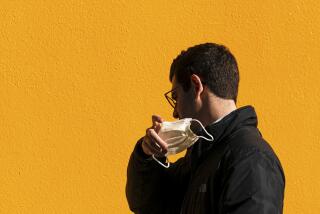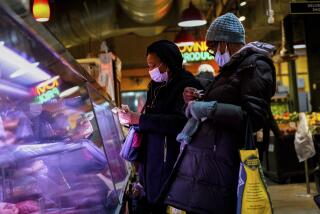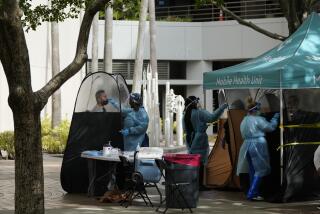Fear and anxiety spike in coronavirus hot spots across U.S. as Trump downplays pandemic

- Share via
Preslie Paur breaks down in tears when she thinks of her state’s refusal to mandate face masks.
The South Salt Lake City, Utah, woman can’t work at her special education job due to an autoimmune disease. Her husband, also a special ed teacher, recently quit because his school district would not allow him to work remotely to protect her and their 5-year-old son, who has asthma.
“I feel forgotten,” Paur said. “We’re living in a world we no longer fit in. We did everything right. We went to college, we got jobs, we tried to give back to our community, and now our community is not giving back to us. And I’m very scared.”
As President Trump barnstorms the battleground states, often downplaying the COVID-19 pandemic before largely unmasked crowds, the nation continues to lurch toward what his opponent Joe Biden, citing health experts, warned will be a “dark winter” of disease and death.
White House Chief of Staff Mark Meadows told CNN on Sunday that “we’re not going to control the pandemic.” Asked why, he said it’s “because it is a contagious virus just like the flu.”
Vice President Mike Pence, meanwhile, will continue campaigning despite his chief of staff testing positive for the coronavirus. His office said Pence and his wife both tested negative for the virus Sunday.
A new timeline from President Trump’s doctors, if accurate, would mean Trump held events while knowing he was sick, potentially exposing supporters, employees and others. The White House quickly tried to walk back some of the comments.
About half of U.S. states have seen their highest daily infection numbers so far at some point in October, and the country as a whole came very close to back-to-back record daily infection rates on Friday and Saturday.
Data from Johns Hopkins University show that 83,718 new cases were reported Saturday, just shy of the 83,757 infections reported Friday. Before that, the most cases reported in the United States on a single day had been 77,362, on July 16.
The Institute for Health Metrics and Evaluation at the University of Washington, which federal health officials have used as a source for their pandemic projections, currently forecasts that the U.S. COVID-19 death toll could exceed 318,000 by Jan. 1.
As of Sunday, there were nearly 8.6 million confirmed infections in the U.S., with 224,906 deaths, according to the Johns Hopkins Coronavirus Resource Center.
At least seven states — Alaska, Colorado, Illinois, Michigan, New Mexico, Ohio and Oklahoma — saw record high infection levels Saturday. And some Northeastern states hit hard in the spring are seeing numbers bounce back; New Jersey’s toll of 1,909 new infections Saturday was the most it had seen in a day since early May.
The virus also is surging in the Mountain West, especially Idaho and Utah.
In Twin Falls, Idaho, new data suggest that 1 in 24 residents has contracted the coronavirus, said Dr. Joshua Kern, vice president of medical affairs at St. Luke’s Magic Valley Medical Center. Amid a crush of new cases, the hospital brought in nurses from Boise, scaled back elective surgery and, as of Friday, stopped admitting pediatric patients.
“It’s gotten kind of out of hand,” Kern told the Associated Press. “We’ve had something like a third of our total COVID cases in our community in the last two to three weeks. There are a lot of parts of the state suffering under the same burden.”
Kern said Twin Falls had been lulled into complacency after months of relatively low numbers, adding “going back to school was the signal to our communities that we can get back to normal.”
“It’s like the community said, ‘Oh, good. It’s over. We can party again,’ and we saw the virus increase,” he said. “This week, we went to the coffee shop to get pastries for our group, and it was closed because of COVID. And we knew that the week before, they had been in there unmasked.”
Mark Chidichimo, a retired FBI agent, said his sister, brother-in-law, brother, nephew and 92-year-old father in Idaho have all been diagnosed with COVID-19 in the last three weeks.
Chidichimo, who lives in New Jersey, had nothing but praise for St. Luke’s in Twin Falls, but said his brother was told that if he needed hospitalization, he’d be sent to Seattle, more than 600 miles away.
“Hey, Idaho. This is coming from someone who has been there, done that: You really want to avoid this if you can,” he said. “It’s going to be really bad, and I pray to God that none of my family members have to be hospitalized. Because if they do, I don’t know if they’ll survive.”
After months of improvement, parts of Europe are going back into lockdown or ramping up restrictions again amid a spike in infections. Italy imposed at least a month of new restrictions across the country on Sunday, insisting that people outdoors wear masks, shutting down gyms, pools and movie theaters, and putting an early curfew on cafes and restaurants.
German Health Minister Jens Spahn, who tested positive Wednesday, pleaded with citizens to wear masks as the virus spikes across the country and hospital ICUs are filling up again.
“Please continue to help and don’t listen to those who play down [coronavirus],” he said. “It is serious.”
In New Mexico, which reported record numbers of additional COVID-19 cases and hospitalizations in recent days, more than 350 doctors, nurses and other healthcare professionals signed a letter imploring residents to stay home as much as possible, wear masks and limit large gatherings to help prevent another wave of “lonely deaths.”
“Please help health care professionals help you,” said the letter, posted on the state Department of Health’s website. “Help us protect you. Help us ensure that we have the resources to treat the sick and care for the dying.”
On Saturday, New Mexico officials reported 875 new cases and five additional deaths, increasing the state’s totals to 41,040 cases and 965 deaths. The number of COVID-19 hospitalizations increased to 264, up from a record 229 on Friday, which topped the previous high of 223 from mid-May.
Paur, whose brother and his girlfriend both recently tested positive for the virus, is worried about them, and herself.
“People need to know that our lives are on the line,” the Utah woman said. “We’re running out of money really fast.”
More to Read
Sign up for Essential California
The most important California stories and recommendations in your inbox every morning.
You may occasionally receive promotional content from the Los Angeles Times.














